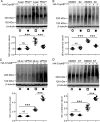Protein kinase g positively regulates proteasome-mediated degradation of misfolded proteins
- PMID: 23770744
- PMCID: PMC3761383
- DOI: 10.1161/CIRCULATIONAHA.113.001971
Protein kinase g positively regulates proteasome-mediated degradation of misfolded proteins
Abstract
Background: Proteasome functional insufficiency is implicated in a large subset of cardiovascular diseases and may play an important role in their pathogenesis. The regulation of proteasome function is poorly understood, hindering the development of effective strategies to improve proteasome function.
Methods and results: Protein kinase G (PKG) was manipulated genetically and pharmacologically in cultured cardiomyocytes. Activation of PKG increased proteasome peptidase activities, facilitated proteasome-mediated degradation of surrogate (enhanced green fluorescence protein modified by carboxyl fusion of degron CL1) and bona fide (CryAB(R120G)) misfolded proteins, and attenuated CryAB(R120G) overexpression-induced accumulation of ubiquitinated proteins and cellular injury. PKG inhibition elicited the opposite responses. Differences in the abundance of the key 26S proteasome subunits Rpt6 and β5 between the PKG-manipulated and control groups were not statistically significant, but the isoelectric points were shifted by PKG activation. In transgenic mice expressing a surrogate substrate (GFPdgn), PKG activation by sildenafil increased myocardial proteasome activities and significantly decreased myocardial GFPdgn protein levels. Sildenafil treatment significantly increased myocardial PKG activity and significantly reduced myocardial accumulation of CryAB(R120G), ubiquitin conjugates, and aberrant protein aggregates in mice with CryAB(R120G)-based desmin-related cardiomyopathy. No discernible effect on bona fide native substrates of the ubiquitin-proteasome system was observed from PKG manipulation in vitro or in vivo.
Conclusions: PKG positively regulates proteasome activities and proteasome-mediated degradation of misfolded proteins, likely through posttranslational modifications to proteasome subunits. This may be a new mechanism underlying the benefit of PKG stimulation in treating cardiac diseases. Stimulation of PKG by measures such as sildenafil administration is potentially a new therapeutic strategy to treat cardiac proteinopathies.
Keywords: cardiomyopathies; cyclic GMP-dependent protein kinase; desmin; proteasome inhibitors; proteins.
Conflict of interest statement
Figures








Comment in
-
PKG primes the proteasome.Circulation. 2013 Jul 23;128(4):325-7. doi: 10.1161/CIRCULATIONAHA.113.003955. Epub 2013 Jun 14. Circulation. 2013. PMID: 23770743 No abstract available.
References
-
- Chen Q, Liu JB, Horak KM, Zheng H, Kumarapeli AR, Li J, Li F, Gerdes AM, Wawrousek EF, Wang X. Intrasarcoplasmic amyloidosis impairs proteolytic function of proteasomes in cardiomyocytes by compromising substrate uptake. Circ Res. 2005;97:1018–1026. - PubMed
Publication types
MeSH terms
Substances
Grants and funding
LinkOut - more resources
Full Text Sources
Other Literature Sources
Molecular Biology Databases
Research Materials

